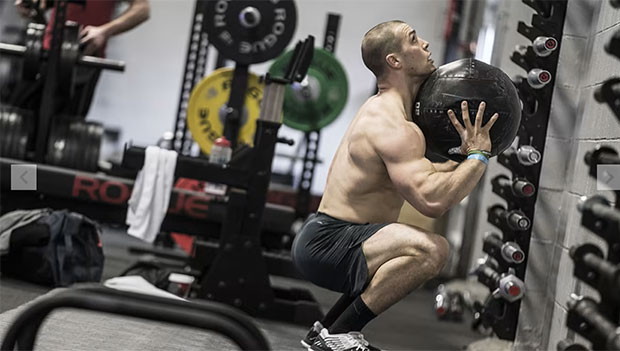
By clicking on the product links in this article, we may receive a commission fee at no cost to you, the reader. Sponsorships and affiliate commissions help support our research so we can help you find the best products. Read the full affiliate disclosure here.
I love functional training. If you ask members of my family about "Cory’s Usable Strength Workout" they’ll tell you stories from when I was a teenager doing bear crawls down the driveway, climbing trees with a weighted vest, or walking seven miles home from school with a backpack full of books and calling it a ruck. I always wanted to be functionally strong, aka strength that I could use in real-life situations, not just at the gym.
I’ve learned a lot about balance since then, but the truth is, I’m still hooked on functional training. I’m a sucker for social media ads about sandbags, slam balls, medicine balls, and any other functional equipment I can fit in the small shed I call my home gym. But for now, I want to settle the slam ball vs. medicine ball debate once and for all and discuss what each is used for, how they differ, and which one may be right for you. Plus, I’ve outlined a few recommendations if you’re ready to start the functional fitness journey ASAP.
Why Trust Us?
The health and safety of ACTIVE’s readers is of the utmost importance to us. To ensure your well-being when consuming protein powders, the ACTIVE.com editorial team prioritizes products that are independently tested by a third-party. We’ve also consulted with a team of nutritionists and dieticians to ensure the products we feature are of the highest standard. This helps us create the most accurate, authentic review content for our readers. More importantly, fitness may be our job, but it is also our passion. Therefore, we strive to bring you products that we trust and would personally use.
Slam Ball
Slam balls are exactly what the name implies. They’re weighted and usually coated in some form of rubber or leather so you can throw them around in various ways without worrying about breaking your equipment. It may sound silly when I put it that way, and I’m half-joking. But the truth is that throwing motions are very functional, and training with a slam ball has a lot of benefits.
The key to a slam ball’s effectiveness is its shape and weight. Your body is not used to holding a large ball that is heavy so you’re challenging your muscles to apply the strength they have to new situations. This is the basis of functional training, which I am a huge fan of.
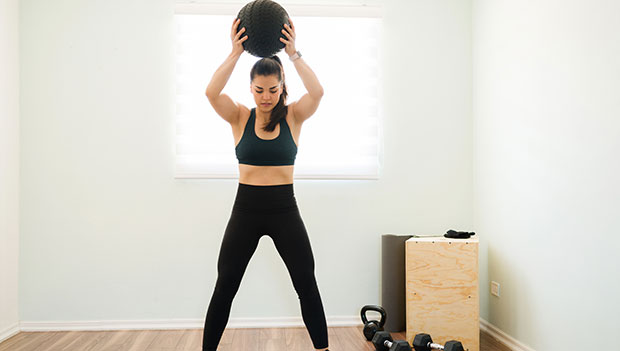
Slam Ball Benefits
- Helps burn fat
- Helps boost metabolism after your workout
- Helps improve muscle density
- Helps improve sports performance
- Helps increase aerobic capacity
- Aids in faster muscle recovery post-workout
Slam Ball Exercises
The best part about functional training equipment like slam balls is the versatility. You can do so many exercises with this equipment that I can’t include the whole list, but three of my favorites are below. Besides these, you can also use a slam ball for any ab work you would normally do with a dumbbell or kettlebell.
Ball Slams
What: The namesake of the slam ball is the overhead slam. This is a simple exercise where you raise the slam ball over your head with both hands and slam it down in front of you with force.
Why: Overhead slams make your major muscle groups work together to transfer force. Your body does this every day when you’re lifting your kid, taking out the trash, or mowing the lawn. Improving that process will benefit you in all of your daily activities and keep you from developing muscular pain from overcompensating due to a weakness in the chain.
How:
- Stand with your feet about shoulder-width apart and your slam ball in your hands.
- Raise the slam ball overhead with fully extended arms.
- Tighten your core and slam the ball on the ground as hard as you can, finishing in a squat position.
- Return to the starting position and repeat for reps.
Wall Balls
What: Wall balls are a basic squat with a dynamic throw. You’ll need a wall, obviously, and a fixed point that you’re aiming for.
Why: Wall balls get your heart pumping because they’re combining a strength training exercise with a dynamic plyometric exercise. If you do enough reps you’ll feel the burn in your legs, arms, and abs.
How:
- Start with your feet about shoulder-width apart, holding a slam ball in both hands at chest height. Face the wall.
- Squat down until your hips are just below your knees. As best you can keep your back straight. Visualize sitting down in a chair to help with the form.
- As you drive your body back to the upright position through your feet, throw the slam ball to the target point on the wall and catch it as it falls. Reset and repeat for reps.
Lateral Throws
What: Lateral throws are simple in theory, you throw the slam ball against the wall using your rotational muscles. But you have to pay attention to your form because you can easily tweak a weak rotational muscle if it’s not used to being worked.
Why: The muscles responsible for your body’s rotation can go overlooked if you don’t target them. Lateral throws mimic common daily tasks that require you to rotate and activate your obliques, hips, and lower back muscles.
How:
- Stand with either your left or right side facing a wall. You’ll need a few feet between you and the wall for this exercise.
- Plant your feet about shoulder width apart and hold a slam ball about waist high. You can bend your knees slightly to get a more activated core for the exercise.
- Twist your torso away from the wall. Think of this as a wind-up.
- With force twist back toward the wall and throw the ball at the target. Repeat for reps.
Our Slam Ball Recommendations
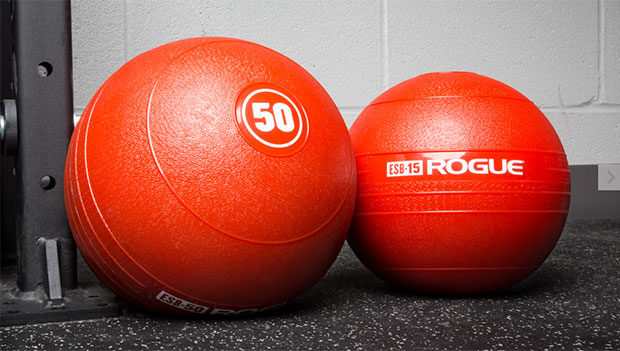
It’s hard to mess up a slam ball, but one thing to watch out for is cheap rubber coating. The repeated impact will cause some major wear and tear so a good, durable ball is worth paying a little bit more for. Here are a few brands you know you can trust:
Medicine Ball
Medicine balls are very similar to slam balls. In fact, you’ll probably find some brands online that use the terms interchangeably. But the subtle differences are important because they’ll affect what you can actually do with the ball.
Don’t get me wrong. You can use a medicine ball for slams, but you won’t get as much use out of them before they need to be replaced. When you think of a medicine ball, think of balance and strength instead of explosiveness. You use the weight to shift the load your muscles are bearing just enough to get them out of their comfort zone.
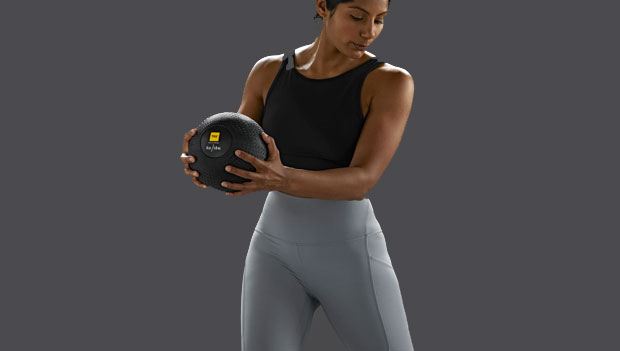
Medicine Ball Benefits
- Helps increase balance and coordination
- Helps boost muscular endurance
- Helps stabilizes your muscular chain
- Helps tone muscles
Medicine Ball Exercises
Just like slam balls, medicine balls are versatile and I can’t list all of the exercises in this article. But here are a few common ones to help you see how medicine balls differ in function.
Medicine Ball Squat
What: Medicine ball squats can be performed in multiple ways. You can keep the weight under your chin similar to a goblet squat, you can push the weight overhead, or you can hold the weight in front of your body.
Why: No matter where you put the weight, your stabilizing muscles in your core, chest, and shoulders will be on fire trying to keep your balance as you squat.
How:
- Stand with your feet planted on the ground about shoulder-width apart. Hold a medicine ball in your preferred position.
- Squat down until your hips are parallel or below your knees. Keep your back straight and your weight stabilized.
- Drive through your feet back to the starting position. Repeat for reps.
Medicine Ball Push-Up
What: The key to medicine ball push-ups is being off balance. You can put one hand or both hands on the medicine ball and your body will shake as you perform the push-up because you’re fighting to stay balanced in an awkward position. If you go with one hand, try rolling the ball to your other hand between each rep.
Why: When you perform a simple exercise enough you’re going to plateau eventually. But that doesn’t mean the exercise is worthless, it just means you need to add a new challenge to it. Putting your body off balance for a push-up is a great way to train your whole torso.
How:
- Get into a push-up position. Your body should make a straight line from your head to your feet. Both hands can be on the medicine ball or one hand.
- Lower your chest to the floor, keeping your core tight and your body posture straight.
- Drive through your hands back to the starting position. Repeat for reps.
Russian Twist
What: You may have done a weighted Russian twist before. Most people use dumbbells, kettlebells, or weight plates. But a medicine ball doesn’t have a handle so you’ll feel the difference trying to keep the weight steady while performing the movement.
Why: When you’re picking something up in real life, you don’t always have a handle to hold to transfer the weight to your larger muscles. Holding a medicine ball during an off-balance movement like a Russian twist will train your grip to adapt and stabilize awkward weight.
How:
- Sit on the floor with your knees bent and feet planted on the floor. Squeeze the medicine ball with both hands, one on each side. You can either keep your elbows out or alternatively extend your arms to hold the weight away from you for a greater challenge.
- Lean your torso back slightly, forming a V shape with your knees. Make sure to tighten your core and back straight. Don’t lean back far enough to where you round your back.
- Slow twist your torso and the medicine ball to one side, touching the ground with the weight before returning to the starting position. Repeat on the opposite side, switching back and forth for reps.
Our Medicine Ball Recommendations
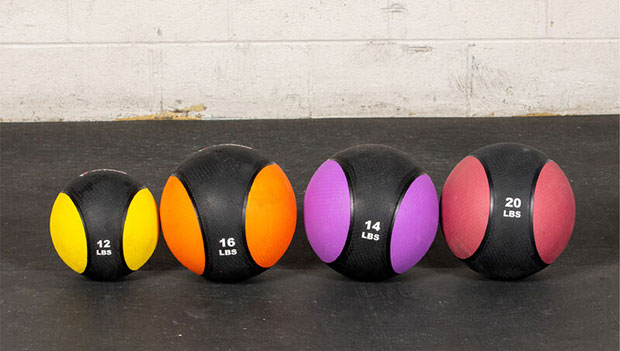
- Rogue Medicine Balls
- REP Fitness Medicine Balls
- Titan Fitness Rubber Medicine Balls
- TRX XD Kevlar Rubber Medicine Balls
Slam Ball vs. Medicine Ball: What’s the Difference?
The main difference between slam balls and medicine balls is the coating. Slam balls have a soft coating that can absorb impact while medicine balls have a harder coating that is textured for a good grip.
Many people use medicine balls and slam balls interchangeably for exercises, but some of the higher-impact exercises can damage medicine balls with hard coating.
Slam Ball vs. Medicine Ball: Which is Right for You?
If you’re asking me, which I guess you are if you’re reading this comparison, I personally recommend slam balls over medicine balls. The bottom line is you can do all medicine ball exercises with a slam ball but that’s not necessarily true the other way around.
Want to train explosively? Slam ball.
Want to train your balance and tone muscles? Medicine ball.
FAQs About Slam vs. Medicine Balls
Are medicine balls best for beginners?
Medicine balls are great equipment for beginners who want to build muscular endurance, balance, and core strength.
Can I use a slam ball as a medicine ball?
Yes, you can use a slam ball for any medicine ball exercises. Keep in mind though that slam balls won’t have as much grip as medicine balls.
How heavy of a slam ball should I get?
How heavy your slam ball should be will depend on your strength level. It is always better to get a lighter ball and practice technique than it is to get a heavier ball and risk injury.
How often should you use a medicine ball?
Depending on the exercise, you can use a medicine ball as frequently as you want to. Most medicine ball exercises are low impact and use body weight so you should have faster recovery times than traditional weight training.
About the Author

Cory is a certified personal trainer and fitness nutrition coach. After spending six years as an educator and coach, Cory joined the ACTIVE team as a staff writer turning his passion for education toward helping ACTIVE readers live their best, healthiest lives.
Get ACTIVE on the Go


Couch to 5K®
The best way to get new runners off the couch and across the finish line of their first 5K.
Available for iOS | Android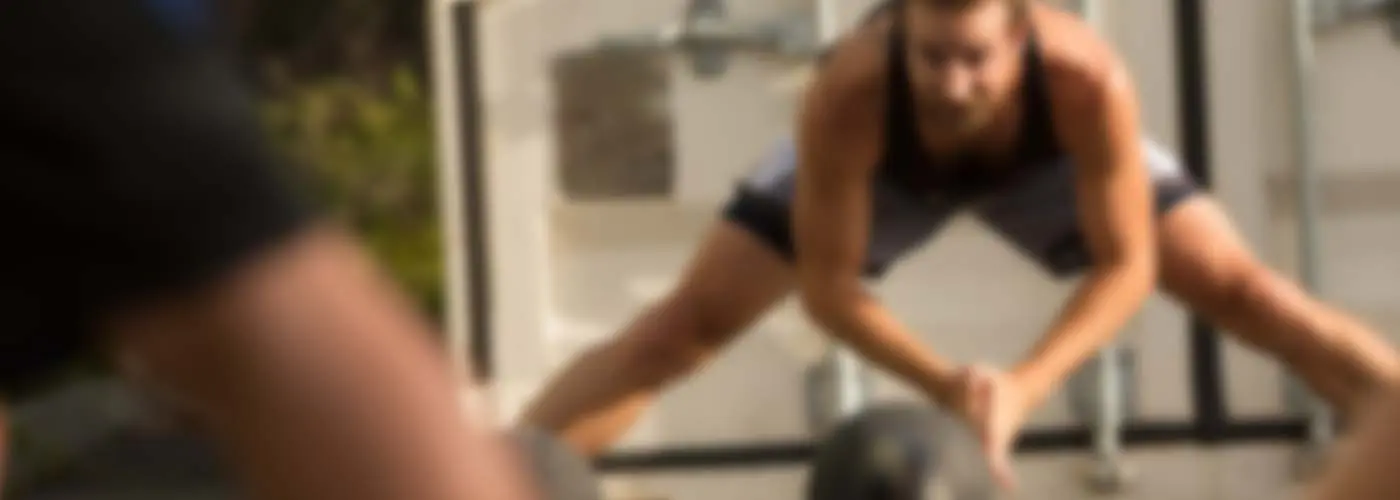
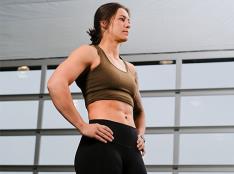




Discuss This Article